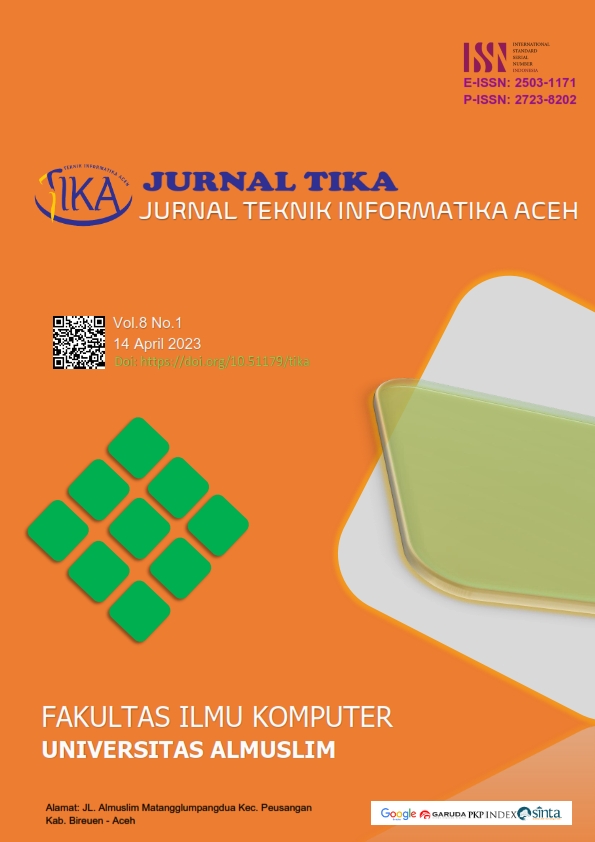Development Of Android And Microcontroller-Based Home Security System Prototypes
DOI:
https://doi.org/10.51179/tika.v8i1.1858Keywords:
Arduino Uno, Android, Microcontroller, Selenoid Door Lock, Home Security SystemAbstract
The current industrial revolution is marked by the emergence of various computer-based devices with certain specifications to be used to complete certain jobs. This device was born from the development of computers, which were originally devices used to complete simple calculations, with large sizes and required high development costs. Gradually through various studies, a new computer technology was born which has a small size, low power consumption, low development costs and has a much more optimal and intelligent performance. One of the technologies in question is the home security system developed in this study. This system can operate with 4 units of AA batteries connected to the microcontroller and android smartphone. The system built is able to solve the problems that exist in conventional door security systems that use physical locks with the following weaknesses: 1) Physical locks that are easily damaged; 2) Keys are easy to lose; 3) Limited keys, because door lock manufacturers only provide 3-4 spare keys, which means one set of keys can only be used by 3-4 users; 4) Security is not guaranteed, because currently physical keys can be easily duplicated by locksmiths on the market today. The results of this study are the development of a prototype home security system using an Android smartphone and a microcontroller. The user only needs to access the system via an Android smartphone, then the system will authorize the user, if the user is an authorized user, the system will forward the command to the relay to deactivate the selenoid door lock. The built system also has an alarm feature that is generated by a buzzer when an entry attempt is made by an unregistered device
Downloads
References
Alwendi, A. (2021). Optimalisasi Internet of Things untuk Meningkatkan Produksi pada Sektor Usaha Kecil dan Menengah di Masa Pandemi Covid-19. Jurnal Informatika Dan Rekayasa Perangkat Lunak, 3(1). Retrieved from https://doi.org/10.36499/jinrpl.v3i1.3963
Andriani, Y. F., Noor, M. F., Salim, A. S., & Hanafi. (2019). Internet Of Things (Iot) – Tantangan Dan Keamanan Iot Menggunakan Enkripsi AES. Jurnal INFORMA Politeknik Indonusa Surakarta, 5(1).
Anwari, H., & Pramukantoro, E. S. (2017). Pengembangan Iot Middleware Berbasis Event-Based dengan Protokol. Jurnal Pengembangan Teknologi Informasi Dan Ilmu Komputer, 1(12).
Dewi, R., Johan, T. M., & Muslem R., I. (2021). Aplikasi Kriptografi Dalam Mengamankan Pesan Teks Dengan Metode Algoritma Rc4 Berbasis Android. JURNAL TIKA, 6(01). Retrieved from https://doi.org/10.51179/tika.v6i01.416
Firmansyah, A. (2019). Analisis Tantangan dan Peluang dalam Implementasi IoT Smart City di Indonesia. Academia.Edu.
Fitriani, F., & Muslem R, I. (2021). E-Absensi Mahasiswa Fakultas Ilmu Komputer Universitas Almuslim Berbasis Web. JURNAL TIKA, 5(3). Retrieved from https://doi.org/10.51179/tika.v5i3.141
Harsanto, B. (2020). INOVASI INTERNET OF THINGS PADA SEKTOR PERTANIAN: PENDEKATAN ANALISIS SCIENTOMETRICS. Informatika Pertanian, 29(2). Retrieved from https://doi.org/10.21082/ip.v29n2.2020.p111-122
Hasanah, H. (2017). TEKNIK-TEKNIK OBSERVASI (Sebuah Alternatif Metode Pengumpulan Data Kualitatif Ilmu-ilmu Sosial). At-Taqaddum, 8(1). Retrieved from https://doi.org/10.21580/at.v8i1.1163
Megawati, S. (2021). Pengembangan Sistem Teknologi Internet of Things Yang Perlu Dikembangkan Negara Indonesia. Journal of Information Engineering and Educational Technology, 5(1). Retrieved from https://doi.org/10.26740/jieet.v5n1.p19-26
Muslem, I. (2021). Prototype Kunci RFID (Radio Frequency Identification) dalam Meningkatkan Keamanan Kendaraan Bermotor. JURNAL TIKA, 5(3). Retrieved from https://doi.org/10.51179/tika.v5i3.104
Muslem R, I. (2021). Sistem Pendeteksi Kebocoran Gas Rumah Tangga Menggunakan Mq-2 Sensor Dan Mikrokontroler. JURNAL TIKA, 6(02). Retrieved from https://doi.org/10.51179/tika.v6i02.457
NUGRAHA, A. W. W., ROSYADI, I., & KHOERULLATIF, F. (2021). Penerapan DevOps pada Sistem Tertanam dengan ESP8266 menggunakan Mekanisme Over The Air. ELKOMIKA: Jurnal Teknik Energi Elektrik, Teknik Telekomunikasi, & Teknik Elektronika, 9(3). Retrieved from https://doi.org/10.26760/elkomika.v9i3.678
Purnomo, M., Maulina, E., Wicaksono, A. R., & Rizal, M. (2021). Adopsi Teknologi Internet of Things pada Startup Industri F&B. Techno.Com, 20(3). Retrieved from https://doi.org/10.33633/tc.v20i3.4824
Raharjo, M. (2008). Metode Pengumpulan Data Penelitian Kualitatif. Animal Genetics, 39(5).
Suparno, I. W., & Jalil, A. (2021). SENSOR MULTI-MODAL UNTUK DETEKSI GERAK OBJEK PADA SISTEM KEAMANAN RUMAH BERBASIS KOMUNIKASI NODE ROBOT OPERATING SYSTEM. Electro Luceat, 7(1).
Utomo, T. P. (2019). Potensi Implemntasi Internet of Things ( Iot ) Untuk Perpustakaan. Buletin Perpustakaan Universitas Islam Indonesia, 2(1).
Wahyuni, R., Irawan, Y., Noviardi, Z. P., & Yulanda, Y. (2020). ALAT PENGAMAN PINTU DENGAN PASSWORD MENGGUNAKAN ARDUINO UNO AT MEGA 328P DAN SELENOID DOOR LOCK. I N F O R M A T I K A, 12(1). Retrieved from https://doi.org/10.36723/juri.v12i1.196
Downloads
Published
How to Cite
Issue
Section
License
Copyright (c) 2023 T. Muhammad Johan

This work is licensed under a Creative Commons Attribution-ShareAlike 4.0 International License.


